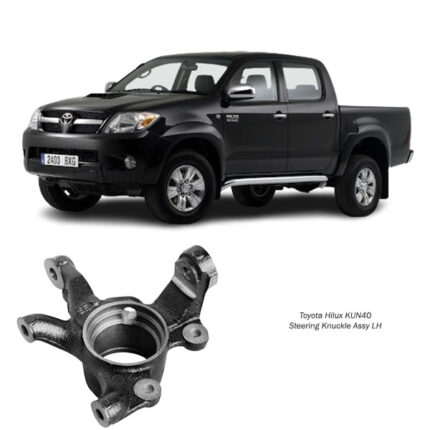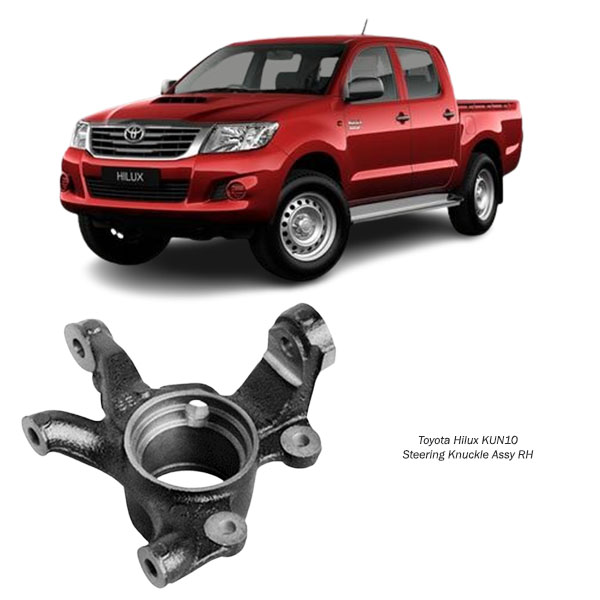-9%
Get Toyota Hilux KUN10 Steering Knuckle Assy RH 43211-0K070 in Kenya
While it might sit hidden behind your front wheels, the Steering Knuckle Assembly RH (Right Hand) is one of the most important structural components in your vehicle’s suspension and steering system. It’s strong, complex, and plays a crucial role in how your vehicle handles, steers, and stops. 💡
Despite its rugged nature, it performs an incredibly delicate dance — balancing forces, absorbing impact, and transmitting motion — all to give you a smooth, safe, and responsive driving experience. Let’s explore what makes the steering knuckle assembly RH such an essential part of your vehicle. 🚗💨
What Is the Steering Knuckle Assembly RH? 🤓
The steering knuckle is a heavy-duty metal component found in the front suspension system. The RH, or Right Hand, version is installed on the passenger side of the vehicle in left-hand drive configurations. It serves as the central connection point between the wheel, suspension system, braking components, and steering linkage.
Imagine it as the “hub of activity” where all front-end motion converges. It’s where movement from the steering wheel is translated into wheel rotation, where braking force is applied, and where suspension travel is absorbed. All of this happens on a structure that is precisely machined, incredibly strong, and highly durable. ⚙️💪
What the Steering Knuckle Does 🧩
Despite its compact size, the steering knuckle handles multiple critical responsibilities:
🔁 1. Supports Wheel Hub and Bearings
The knuckle provides a solid mounting surface for the wheel hub and bearing. This allows the wheel to spin freely while maintaining its vertical and lateral position on the vehicle.
🧭 2. Connects Steering to the Wheels
Through its connection with the tie rod, the knuckle transfers movement from the steering system to the wheels, enabling precise left or right turns.
🛑 3. Mounts Brake Components
Brake calipers are bolted directly to the knuckle, which helps apply force to the brake rotors (also mounted via the hub), allowing the vehicle to slow down or stop efficiently.
🧱 4. Integrates with Suspension
The knuckle connects to the lower control arm and either an upper control arm or a strut, depending on the suspension design. This allows the wheel to move up and down with the terrain while staying aligned with the chassis.
⚖️ 5. Transfers Load
It bears a portion of the vehicle’s weight and transfers that load through the suspension to the wheels and road. It must be strong enough to handle thousands of pounds of force, especially during braking or sharp turns.
What’s Typically Included in a Knuckle Assembly? 🧰
The term “assembly” means the steering knuckle comes pre-equipped with some of the components that are usually mounted on or work with it. Here’s what may be included:
-
Wheel hub: The base where the wheel mounts and rotates.
-
Wheel bearing: Enables smooth, low-resistance wheel spin.
-
Dust shield: Protects brake and hub components from road debris.
-
ABS sensor mounts: Allows placement of wheel speed sensors. 🧲
-
Mounting brackets: For attaching brake calipers and other components.
-
Ball joint & control arm attachment points: Ensures tight integration with suspension geometry.
These pre-installed features save time and reduce complexity when replacing or servicing the component. 🛠️🔧
How It’s Built 🏗️
The RH steering knuckle is typically manufactured from cast iron, forged steel, or aluminum alloy, depending on the performance and durability requirements. Each material has its strengths:
-
Cast iron offers solid durability and cost-effectiveness.
-
Forged steel provides superior strength for high-load applications.
-
Aluminum alloy reduces unsprung weight, improving handling in performance setups.
Its shape is designed with precision to ensure proper alignment, load distribution, and component compatibility. Even a slight deviation in its geometry could affect suspension angles, tire wear, and steering response. That’s why quality and fitment are so important. 🔍📏
Why It’s So Important 🚨
Although it’s rarely seen or mentioned, the RH steering knuckle is a cornerstone of vehicle safety and handling. Here’s why:
-
🧷 It holds the wheel in the correct position and alignment.
-
🛞 It maintains tire contact with the road.
-
🛠️ It allows your wheels to turn smoothly and predictably.
-
🛑 It keeps your brake system solidly mounted.
-
🧭 It supports accurate steering input and response.
Together with its LH counterpart, the RH knuckle makes sure your vehicle behaves as expected — whether you’re navigating sharp turns, sudden stops, or rough terrain. 🌪️🛣️
Common Signs of Problems ⚠️
Even though the steering knuckle is built tough, it’s not immune to damage — especially under harsh driving conditions or after an accident. Here are some signs that might indicate a problem:
🌀 Unstable Steering
Wandering, drifting, or play in the steering wheel could mean that the knuckle or its mounting points are worn or damaged.
🚧 Vehicle Pulling to One Side
If your car consistently veers in one direction, a bent or misaligned knuckle could be affecting the wheel alignment.
🔊 Clunking or Popping Sounds
These noises during turning or going over bumps could indicate excessive wear or damage where the knuckle connects to ball joints or tie rods.
👟 Uneven Tire Wear
Improper suspension geometry caused by a warped or misaligned knuckle can lead to faster tire wear on one side.
🚨 ABS Light On
Since the knuckle often holds the ABS sensor, damage or misalignment can disrupt the sensor’s signal, triggering a warning light.
If any of these issues are present, it’s wise to have the knuckle — along with other suspension and steering components — inspected and replaced if necessary. Safety first! 🛑🧰
Installation Tips and Care 🧼
-
Make sure the replacement knuckle matches the exact orientation (RH) and design of the original.
-
Torque all bolts to manufacturer specifications for safety and performance.
-
If the knuckle includes pre-pressed components (like bearings or hubs), double-check for smooth rotation and proper seating.
-
After installation, always get a professional wheel alignment to ensure handling and tire wear remain optimal. 📏🔩
Conclusion: Small Part, Big Role 💯
The Steering Knuckle Assembly RH might not be flashy, but it’s truly one of the unsung heroes beneath your vehicle. It manages the delicate balance between strength and precision, playing a central role in how your car steers, brakes, and handles daily road conditions.
From sharp turns to sudden stops, from bumpy streets to smooth highways — this right-hand assembly is always hard at work. Next time you enjoy a stable, smooth, and safe ride, just remember: your RH steering knuckle is doing its job flawlessly in the shadows. 🙌🔩🛞
Follow us on Facebook for more parts.




Reviews
Clear filtersThere are no reviews yet.